Pietermaritzburg
Pietermaritzburg (/ˌpiːtərˈmærɪtsbɜːrɡ/;[4] Zulu: umGungundlovu) is the capital and second-largest city in the province of KwaZulu-Natal, South Africa. It was founded in 1838 and is currently governed by the Msunduzi Local Municipality. Its Zulu name umGungundlovu is the name used for the district municipality. Pietermaritzburg is popularly called Maritzburg in Afrikaans, English and Zulu alike, and often informally abbreviated to PMB. It is a regionally important industrial hub, producing aluminium, timber and dairy products, as well as the main economic hub of Umgungundlovu District Municipality. The public sector is a major employer in the city due to the local, district and provincial governments being located here.
Pietermaritzburg umGungundlovu (in Zulu) City of Choice | |
|---|---|
Pietermaritzburg City Hall | |
| Nickname(s): PMB, Maritzburg | |
 Pietermaritzburg 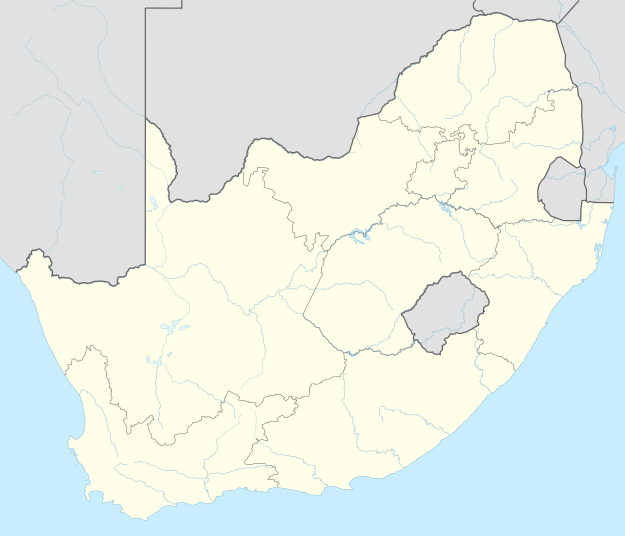 Pietermaritzburg 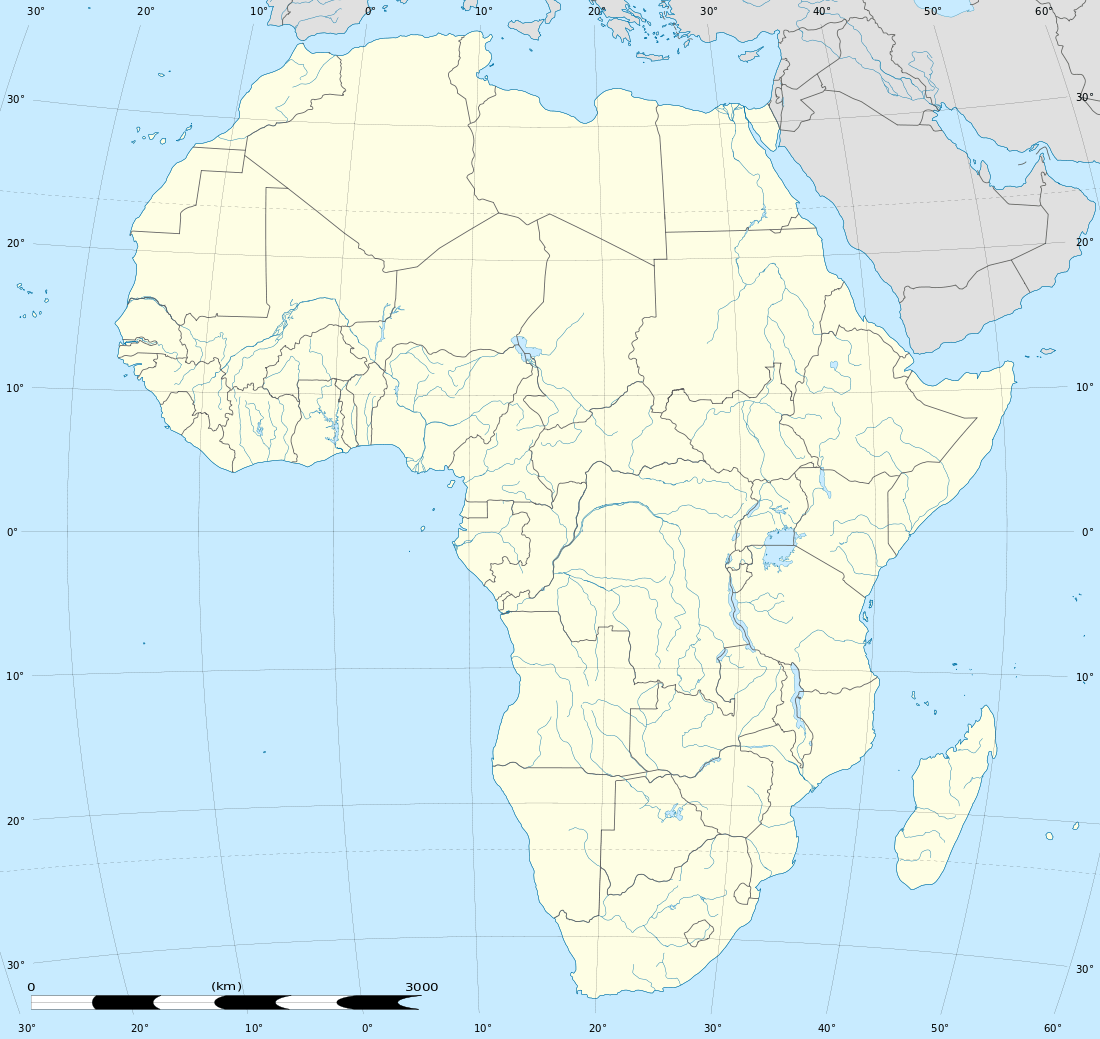 Pietermaritzburg | |
| Coordinates: 29°37′S 30°23′E | |
| Country | |
| Province | KwaZulu-Natal |
| District | uMgungundlovu |
| Municipality | Msunduzi |
| Established | 1839[1] |
| Government | |
| • Type | Local Municipality |
| • Mayor | Themba Njilo[2] (2011) (ANC) |
| Area | |
| • Total | 126.15 km2 (48.71 sq mi) |
| Elevation | 596 m (1,955 ft) |
| Population (2011)[3] | |
| • Total | 223,448 |
| • Density | 1,800/km2 (4,600/sq mi) |
| Racial makeup (2011) | |
| • Black African | 70.0% |
| • Coloured | 6.9% |
| • Indian/Asian | 8.4% |
| • White | 14.2% |
| • Other | 0.5% |
| First languages (2011) | |
| • Zulu | 57.0% |
| • English | 28.9% |
| • Afrikaans | 4.2% |
| • Xhosa | 3.5% |
| • Other | 6.3% |
| Time zone | UTC+2 (SAST) |
| Postal code (street) | 3201 |
| PO box | 3200 |
| Area code | 033 |
| Website | www |
It is home to many schools and tertiary education institutions, including a campus of the University of KwaZulu-Natal. It had a population of 228,549 in 1991;[5] the current population is estimated at over 600,000 residents (including neighbouring townships) and has one of the largest populations of Indian South Africans in South Africa.
History
The city was founded by the Voortrekkers, following the defeat of Dingane at the Battle of Blood River, and was the capital of the short-lived Boer republic, Natalia. Britain took over Pietermaritzburg in 1843 and it became the seat of the Natal Colony's administration with the first lieutenant-governor, Martin West, making it his home. Fort Napier, named after the governor of the Cape Colony, Sir George Thomas Napier, was built to house a garrison. In 1893, Natal received responsibility for their own government and an assembly building was built along with the city hall.
On 7 June 1893, while the young Mahatma Gandhi was on his way to Pretoria, a white man objected to Gandhi's presence in a first-class carriage. Despite Gandhi having a first-class ticket, he was ordered by the conductor to move to the van compartment at the end of the train: he refused, and he was removed from the train at Pietermaritzburg.
Shivering through the winter night in the waiting room of the station, Gandhi made the momentous decision to stay on in South Africa and fight the racial discrimination against Indians there. Out of that struggle emerged his unique version of nonviolent resistance, Satyagraha. Today, a bronze statue of Gandhi stands in Church Street, in the city centre.
In 1910, when the Union of South Africa was formed, Natal became a province of the Union, and Pietermaritzburg remained the capital. During apartheid, the city was segregated into various sections. 90% of the Indian population was moved to the suburb of Northdale while most of its Zulu inhabitants were moved to the neighbouring township of Edendale and white inhabitants were moved out of those areas.
Name
There exist two interpretations about the origin of the city's name. One is that it was named after Piet Retief and Gert (Gerrit) Maritz, two Voortrekker leaders.[6]:43 The other is that it was originally named after Piet Retief alone, since his full name was Pieter Maurits Retief. In this interpretation the original name was "Pieter Maurits Burg", later transliterated to the current name.[7]:11

Retief in fact never reached Pietermaritzburg and was killed by Dingane, successor to Shaka, king of the Zulus. Maritz died of illness on 23 September 1838 near the present-day town of Estcourt, some hundreds of kilometres northwest of Pietermaritzburg. This was after the battle with the Zulus at Bloukranz, and Maritz did not ever reach the Pietermaritzburg area. In 1938, however, the city announced officially that the second element Maritz should also honour Gert Maritz.
At the time of the rise of the Zulu Empire, the site that was to become Pietermaritzburg was called Umgungundlovu. This is popularly translated from the Zulu as "Place of the Elephant", although it could also be translated to mean "The elephant wins". Umgungundlovu is thus thought to be the site of some Zulu king's victory since "Elephant" (Indlovu) is a name traditionally taken by the Zulu monarch. Legend has it that Shaka had his warriors hunt elephant there to sell the ivory to English traders at Durban (then called Port Natal). Today, the town is still called by its Voortrekker name, although the municipality of which it is part bears the Zulu name.
University
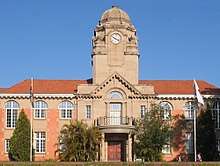
The University of Natal was founded in 1910[8] as the Natal University College and extended to Durban in 1922. The two campuses were incorporated into the University of Natal in March 1949. It became a major voice in the struggle against apartheid and was one of the first universities in the country to provide education to black students. It became the University of KwaZulu-Natal on 1 January 2004.
Other historical events
- The first newspaper in Natal, the Natal Witness (now known as The Witness), was published in 1846.
- The 46 hectare Botanic Gardens were created in 1872 by the Botanic Society of Natal.
- The city hall, which is the largest red-brick building in the Southern Hemisphere, was destroyed by fire in 1895, but was rebuilt in 1901. It houses the largest pipe organ built by the Sheffield organ building company, Brindley & Foster.
- The British built a concentration camp here during the Second Boer War to house Boer women and children.
- During the Second World War, Italian prisoners of war were housed in Pietermaritzburg. During their stay, they built a church, which remains standing as a heritage site today.
- In 1962, Nelson Mandela was arrested in the nearby town of Howick to the north of Pietermaritzburg. The arrest marked the beginning of Nelson Mandela's 27 years of imprisonment. A small monument has been erected at the location of his arrest. Immediately after his arrest Mandela was taken to the Old Prison in Pietermaritzburg.[9] After a night in the prison, he was taken to Magistrate J. Buys's office in the old Magistrates Court Building in Commercial Road (now Chief Albert Luthuli Road), and was remanded for trial in Johannesburg.[10]
Capital status
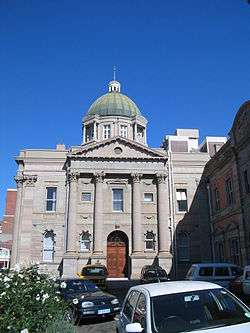
Pietermaritzburg was the capital of the Colony of Natal until 1910, when the Union of South Africa was formed, and Natal became a province of the Union. Prior to 1994, Pietermaritzburg was the capital of Natal Province. Following the first post-apartheid elections in South Africa, as a result of which the Inkatha Freedom Party won a majority in the KwaZulu-Natal provincial government, Pietermaritzburg shared its status as capital of the (then newly created) province of KwaZulu-Natal with Ulundi. Pietermaritzburg became the legislative capital of the new province, while Ulundi became the administrative capital. The IFP, being strongly Zulu nationalist, desired that Ulundi, the capital of the Zulu Kingdom at the time of its fall to the British in the Anglo-Zulu War, be the post-apartheid capital of the province. Ulundi had also been the capital of the bantustan KwaZulu, which makes up a portion of modern KwaZulu-Natal. However, Ulundi severely lacked the infrastructure to be an effective seat of government, and the African National Congress (ANC) and the Democratic Party, the two other strong political parties in the province, among others, called for Pietermaritzburg alone to be the capital. The debate came to an end when the ANC came to power in the province in 2004, and named Pietermaritzburg the sole capital of KwaZulu-Natal. This has resulted in the relocation of several government offices to Pietermaritzburg. This has generally been welcomed as a positive development for the region. Since 2004, progress such as the modernisation of several buildings in the city centre and a proliferation of retail and housing developments in the suburbs are results of recent investment in the city by both the public and private sectors.
Economy
Until the late-1990s, the region was renowned for the production of high quality textile, clothing and footwear products. An example of the latter included the production of Doc Marten shoes. However, these industries have declined in the area due to lower production costs in Asia. Extensive timber plantations and numerous citrus farms surround the city, contributing a significant share of the city's output.
The Liberty Group has made major investments in several phases in the region since 2002 with the development of the Liberty Midlands Mall (the area's largest shopping centre by gross lettable area and its most prestigious) and Stay Easy hotel. Hulett's Aluminium and Willowton cooking oil contributes a substantial part of the region's industrial output.
Coat of arms
The Pietermaritzburg borough council assumed a coat of arms in 1861.[11] The shield depicted an elephant standing on grass, and a cross of five stars was placed above the shield. The motto was Umgungunhlovu. It is unclear what the original colours were, but by 1910 the shield had been coloured blue.[12] By 1931, the council had approved new artwork in which the stars were placed on a radiant sun.[13] The arms were registered with the Natal Provincial Administration in November 1950.[14] Many early renditions of the coat of arms, visible on older public building and wrought iron lampposts, features an elephant which is clearly an Asian Elephant rather than an African elephant. More recent versions reflect an African elephant.
The final version of the arms was granted by the College of Arms in May 1961. It was registered at the Bureau of Heraldry in May 1973.[15] The blazon was : Per fess Azure and Vert, over all an elephant statant Or, tusked Argent (i.e. the shield was divided horizontally into blue over green, and displayed a gold elephant with silver tusks). The crest was changed to a blue sun displaying gold and silver stars, and two black wildebeest were added as supporters. Each had a shield on its shoulder, the dexter supporter's shield displaying the Union Jack and the sinister supporter's the flag of the Natalia republic.
Transport
Road
Pietermaritzburg is on the N3 highway, the primary route between the harbour city of Durban, some 90 kilometres (56 mi) away, and the Pretoria-Johannesburg-Witwatersrand conurbation.
The R33 connects Pietermaritzburg with Lephalale via Greytown, Paulpietersburg, Carolina, Belfast and Vaalwater to the northeast, while the R56 connects Pietermaritzburg with Cape Town via Ixopo, Kokstad, Mthatha, East London, Port Elizabeth, George and Mossel Bay to the southwest. The R56 road becomes co-signed with the N2 highway at Stafford's Post.
Air
The city is served by Pietermaritzburg Airport, which has regular scheduled services to OR Tambo International Airport in Johannesburg and Cape Town International Airport in Cape Town.
Rail
Pietermaritzburg Railway Station is served by trains on the Johannesburg-Durban and Cape Town-Durban routes of Shosholoza Meyl.
It has been mooted that the Metrorail commuter rail system be expanded from Cato Ridge to Pietermaritzburg.
Bus
The Pietermaritzburg Municipality historically operated a tram service, which was closed down in the 1940s, and a bus service, which was closed down in the 1980s.
Nowadays regular daily bus services connect Pietermaritzburg to other major cities in South Africa. The bus station is located on Burger Street, opposite the McDonalds Centre, and it serves major bus companies. Greyhound and Intercape is the most reliable and it operates several round-trips from Durban to Johannesburg daily, where Pietermaritzburg is the second to last stop before Durban.
Taxis
Pietermaritzburg has two types of taxi services: metered taxis and minibus taxis. Unlike in many cities, metered taxis are not allowed to drive around the city to solicit fares and instead must be called and ordered to a specific location. A number of companies service Pietermaritzburg and surrounding areas. These taxis can also be called upon for airport transfers, point to point pickups and shuttles.
Minibus taxis are the standard mode of transport for the majority of the population who cannot afford private vehicles.
Integrated Rapid Public Transport (IRPT)
A bus rapid transit system is currently being developed in Pietermaritzburg.
The initial phase would see the development of a west to east corridor from Edendale to Northdale. The BRT route will traverse the CBD along Church Street.
Geography
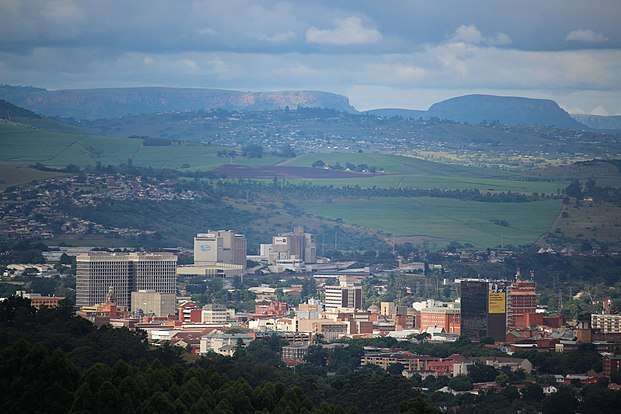
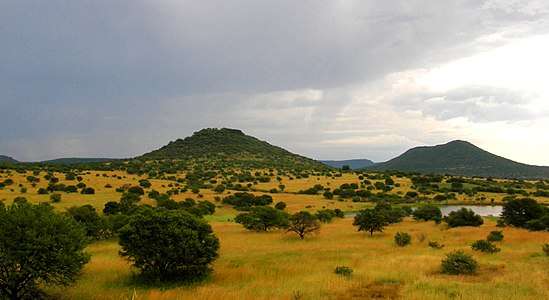
Climate
Pietermaritzburg has a dry-winter humid subtropical climate (Köppen climate classification: Cwa), with distinct wet and dry seasons. Summers are warm and occasionally hot, with frequent rainfall. Winters are dry with high diurnal temperature variation, with light air frosts being possible.
| Climate data for Pietermaritzburg | |||||||||||||
|---|---|---|---|---|---|---|---|---|---|---|---|---|---|
| Month | Jan | Feb | Mar | Apr | May | Jun | Jul | Aug | Sep | Oct | Nov | Dec | Year |
| Record high °C (°F) | 41 (106) |
39 (102) |
38 (100) |
37 (99) |
37 (99) |
31 (88) |
32 (90) |
35 (95) |
39 (102) |
40 (104) |
41 (106) |
42 (108) |
42 (108) |
| Average high °C (°F) | 28 (82) |
28 (82) |
28 (82) |
26 (79) |
24 (75) |
22 (72) |
23 (73) |
24 (75) |
25 (77) |
25 (77) |
26 (79) |
28 (82) |
26 (79) |
| Average low °C (°F) | 18 (64) |
17 (63) |
16 (61) |
12 (54) |
7 (45) |
3 (37) |
3 (37) |
6 (43) |
10 (50) |
13 (55) |
15 (59) |
16 (61) |
11 (52) |
| Record low °C (°F) | 9 (48) |
10 (50) |
5 (41) |
1 (34) |
−1 (30) |
−4 (25) |
−4 (25) |
−3 (27) |
−1 (30) |
2 (36) |
5 (41) |
6 (43) |
−4 (25) |
| Average precipitation mm (inches) | 155 (6.1) |
121 (4.8) |
113 (4.4) |
44 (1.7) |
30 (1.2) |
13 (0.5) |
2 (0.1) |
8 (0.3) |
64 (2.5) |
74 (2.9) |
100 (3.9) |
108 (4.3) |
832 (32.8) |
| Average precipitation days | 22 | 16 | 15 | 6 | 5 | 3 | 1 | 2 | 10 | 12 | 15 | 16 | 123 |
| Source: South African Weather Service[16] | |||||||||||||
Sport
- The Comrades Marathon takes place annually in June between Pietermaritzburg and Durban. It has been run since 1921 and attracts thousands of entrants. The start of the race alternates between the two cities.
- The yearly Amashovashova is a 106 km (66 mi) road cycling classic race held since 1986 which starts in Pietermartizburg and finishes in Durban. It is normally held in October.
- In January there is an annual canoe race, the Dusi Canoe Marathon, from Pietermaritzburg to Durban. The route follows the Msunduzi River into the Mgeni River, through the Valley of a Thousand Hills into the Inanda Dam and from here to the mouth of the Mgeni River.
- The Midmar Mile is one of the largest open-water swimming events in the world; taking place at Midmar Dam, north of Pietermaritzburg in February every year, it attracts over 16,000 swimmers from around the world.
- The Harry Gwala Stadium is a Multi-purpose stadium, and is mostly used for football matches, it is the home ground of Premier Soccer League club Maritzburg United.
- The Pietermaritzburg Msunduzi Athletics Stadium is currently being developed.
- The Pietermaritzburg Oval is considered one of the most picturesque cricket grounds in South Africa, and it hosted two matches during the 2003 Cricket World Cup.
- Pietermaritzburg cricket ground is notable as one of the two grounds used regularly for first-class cricket that have a tree within the boundary (the other is St Lawrence Ground in Canterbury, Kent).
- Woodburn Stadium is currently used for most club rugby in Pietermaritzburg.
- The Kershaw Park Tennis Complex is a tennis stadium.
- The above facilities form the centre of the Pietermaritzburg sports precinct.
- Between December 1953 and November 1981, Pietermaritzburg had an international standard motor racing circuit located on the outskirts of the city. The Roy Hesketh Circuit measured 2.902 kilometres (1.803 mi). The circuit was named after South African driver Roy Hesketh.[17] During its period of operation it hosted rounds of the South African National Drivers Championship, the Springbok Series[18][19][20] and national Formula Atlantic races. The circuit was also like a second home to Mike Hailwood. The track was known for hosting the Easter races as well – a festival of racing over three days. The expansion of the town of Pietermaritzburg eventually led to the redevelopment of the site as a residential and business zone after racing ceased at the end of 1981. The section from Henry's Knee to the top of Beacon still exists, and is undergoing protection from further development as an important piece of Pietermaritzburg's history. From 1948 until 1953 races were held at the 5.5-kilometre (3.4 mi) Alexandra Park Street Circuit on streets within the town of Pietermaritzburg.[21]
- In 2010, the BMX Racing World Championship took place in the city of Pietermaritzburg between 15 July and 1 August.
- Former Springbok and World Cup Winner Joel Stransky was born in Pietermaritzburg on 16 July 1967, he also matriculated from Maritzburg College.
- Former South African Cricketer Jonty Rhodes was born in Pietermaritzburg on 27 July 1969, he also attended Merchiston Prep school and later matriculated from Maritzburg College.
- South African cricketer David Miller was born in Pietermaritzburg on 10 June 1989.
- The English cricketer Kevin Pietersen was born in Pietermaritzburg on 27 June 1980, as was the Springbok cricketer Cuan McCarthy.
- Pietermaritzburg is home to the oldest football (soccer) club of South-Africa and the African continent : Savages FC PMB, founded in 1882.
Tourism
Some of the area's tourist attractions include; the KwaZulu-Natal Museum, City Hall, Colonial Buildings, Imperial Hotel, Comrades House and SANBI Botanical Gardens.
Attractions in the surrounding areas include; Albert Falls Nature Reserve, Howick Falls, Midmar Public Nature Reserve, Queens Elizabeth Park and World's View.
Education
Schools
- Allandale Primary School
- Arthur Blaxall School
- Ashdown Primary School
- Athlone Primary School
- Nsikayethu Secondary School
- Alexandra High School
- Berg Street Primary School
- Bisley Park Primary School
- C21 Private School
- Carter High School
- Clarendon Primary School School
- Clifton Preparatory School
- Copesville Primary School
- Cordwalles Preparatory School
- Cowan House
- Deccan Road Primary School
- Eastwood Primary School
- Edendale Technical High School
- Epworth School
- Esther Payne Smith Secondary School
- Eastwood Primary School
- Eastwood Secondary School
- Evangelical Seminary of Southern Africa
- Forest Hill Primary School
- Grace College
- Gert Maritz Primary school
- Glenwood Primary School
- Greenhill Primary School
- Hayfields Primary School
- Haythorne Secondary School
- Heather Secondary School
- Hilton College
- Heritage Academy
- H.S Ebrahim School
- Islamia Muslim School
- Kharina Secondary School
- Laddsworth Primary School
- Linpark High School
- Longmarket Girls Primary School
- Marion High School
- Maritzburg College
- Maritzburg Christian School
- Maritzburg Muslim School for Girls
- Merchiston Preparatory School
- ML Sultan Secondary
- Michaelhouse
- Mountain Rise Primary School
- Newholmes Primary School
- Nizamia Islamic School
- Northdale Primary School
- Northlands Primary School
- Northern Park Primary School
- Northbury Park Secondary School
- Orient Heights Primary School
- Panorama Primary School
- Pelham Senior Primary School
- Pietermaritzburg Girls' High School
- Prince Alfred Primary School
- Ramatha Road Primary School
- Raisethorpe Secondary School
- Ridgeview Primary School
- Rosefern Primary School
- Russell High School
- Scottsville Primary School
- Seth Mokitimi Methodist Seminary
- Shri Vishnu Primary School
- Siyahlomula High School
- Silver Heights Secondary School
- Sobantu Secondary School
- Springhaven Primary School
- St. Anne's Diocesan College
- St. Charles College
- St. John's Diocesan School for Girls
- St Joseph's Theological Institute, Cedara
- St. Nicholas Diocesan School
- Suncrest Primary School
- Sweetwaters Primary School
- TPA Primary School
- Union Bible Institute
- Union Park Primary School
- University of KwaZulu-Natal
- Voortrekker High School
- W.A Lewitt Primary School
- The Wykeham Collegiate
- Woodlands Primary School
- Woodlands Secondary School
- Uminathi Christian College
Tertiary institutions
Pietermaritzburg has a well-developed higher system of public universities. Pietermaritzburg is served by two public universities, University of KwaZulu-Natal and Durban University of Technology. There are also many private and public colleges operating in the city, some of the larger colleges are: Umgungundlovu TVET College, Varsity College, and Rosebank College.
Civil society
Pietermaritzburg is home to a number of prominent civil society organisations including the Abahlali baseMjondolo (shackdwellers) movement, GroundWork, CINDI, PACSA, and the KwaZulu Natal Christian Council.[22][23][24][25][26]
Notable residents
- Don Armand, Rugby player (born 23 September 1988)
- Dale Benkenstein, Former Cricketer
- Lwandiswa Zuma South African First-Class Cricketer (born 11 July 1996) attended Maritzburg College
- Kork Ballington, World 250cc and 350cc Motorcycle Champion
- Neil Breytenbach, Prime Circle Keyboardist
- Melissa Carlton, Paralympic swimmer who represented Australia[27]
- Amod Cassimjee, One of the earliest known Indian settlers
- Pat Cilliers, rugby player (born 1987)
- Steve Colenbrander, founder, Colenbrander Incorporated (born 18 June 1960)
- Brendon Dedekind, swimmer (born 14 February 1976)
- Jon Ekerold, World 350cc Motorcycle Champion
- Brett Evans, (born 8 March 1982) South African Football (soccer) player attended Merchiston Preparatory School and Maritzburg College and played for Maritzburg City as an amateur
- Adrian Furnham (born 1953), British-based organisational and applied psychologist and academic
- Tim Groenewald, Derbyshire and Warwickshire Cricketer (born 10 January 1984)
- Hayden Griffin (1943-2013), British stage designer[28]
- Adam Habib, Vice-Chancellor and Principal of the University of the Witwatersrand (Wits), (Born, 1965)
- Jonathan Handley, singer-songwriter (born 5 June 1954), originally from Springs, founder of The Radio Rats who in 1979 had a hit single "ZX Dan" on Radio 5 (now 5FM).
- Bessie Head, writer, was born in Pietermaritzburg in 1937.
- Roy Hesketh, (1915 - 19 September 1944) racing driver and South African Air Force pilot.
- Yakash Jainarain, former Standard Bank Hilton manager, (born 2 October 1992) attended ML Sultan Secondary School
- Butch James, Springbok and Sharks rugby player attended Maritzburg College from 1994 to 2000. He played for Colleges' 3rd team.
- Stratford Johns, (22 September 1925 – 29 January 2002) British stage, film and television actor. Left for Britain in 1948.
- Peter Johnstone, Park Villa FC (born 1 September 1970 in Grey's Hospital,left PMB in 2004
- Craig Joubert, International rugby union referee (born 8 November 1977).Refereed the 2011 Rugby World Cup final.Attended Merchiston Preparatory School and Maritzburg College
- Jesse Kriel, Springbok rugby player (born 15 February 1994).Attended Merchiston Preparatory School and Maritzburg College
- Charlie Llewellyn, cricketer (born 29 September 1876), first non-White Test cricketer for South Africa.
- Mbulelo Mabizela, South African national football team player (born 16 September 1981) Orlando Pirates captain & Tottenham Hotspurs player
- Clinton Marius, writer, performer (born 20 August 1966)
- Thuso Mbedu actress (born 16 July 1991),Nominated for Best Actress at the 2017 Emmy awards.Attended Pietermaritzburg Girls' High School
- Lunga Shabalala, (born 22 May 1989), TV presenter,TV personality and actor. He attended Maritzburg College.
- Cuan McCarthy, fast-bowling The Proteas cricketer 1929–2000
- Phyllis McCarthy, authority on and breeder of Rhodesian Ridgebacks
- Cathcart William Methven (1849–1925), painter, engineer and architect
- Greg Minnaar, three time Downhill World Cup champion (2001, 2005, 2008). He was also crowned Downhill World Champion in 2003. He attended Carter High School.
- Zweli Mkhize, Politician,Former Kwazulu-Natal premier, national minister and South African current minister of health(born 2 February 1956).Born and raised in Willowfountain.Lived in Ashburton,Pietermaritzburg
- Bryce Moon, (born 6 April 1986) South African Football (soccer) player was born in Pietermaritzburg and played for Pirates (PMB) in his youth
- Ryan Moon, South African national football team player (born 15 September 1996).Attended Maritzburg College
- Roshan Morar, founder Morar Incorporated, (Born 1966)
- Shaun Morgan, lead singer of Seether, is a former resident of Pietermaritzburg and attended both Merchiston Preparatory School and Maritzburg College while he lived there.
- Blade Nzimande (born 14 April 1958), South African national minister & president of the South African Communist Party.He attended Georgetown High School, Edendale & the University of Natal.
- Bathabile Dlamini, Leader of the African National Congress Women's League (ANCWL) & Minister of Women in the Presidency, and Minister of Social Development. (born 10 September 1962)
- Archie Gumede, Leader of the United Democratic Front (South Africa) & Member of the Parliament of South Africa
- Alan Paton, author of Cry the Beloved Country, was born and schooled (Maritzburg College) in Pietermaritzburg.
- Vyvyan Pearse (1891–1956), cricketer
- Kevin Pietersen, cricketer (born 27 June 1980).
- Rowland Raw (1884–1915), cricketer
- Jonty Rhodes, national cricketer (born 27 July 1969)
- Andrew Dalby, fighter pilot, historian, sportsman, involuntary dog owner (born 26 November 1970)
- Tom Sharpe, novelist, who described the city as "half the size of a New York cemetery and twice as dead".
- Peter Leslie Smith, Auxiliary Bishop for the Archdiocese of Portland in Oregon (born 1958)
- Guy Spier, Value Investor (born 4 February 1966 in Grey's hospital)
- Dale Stewart, bassist of Seether, former resident of Pietemaritzburg.
- Joel Stransky, Springbok rugby player (Born 16 July 1967).Scored all of South Africa's points in the rugby world cup final to win the 1995 Rugby World Cup.Born in Pietermaritzburg,attended Maritzburg College and University of Natal
- Darian Townsend, swimmer. 2004 Summer Olympics gold medal winner of the men's 4×100-metre freestyle relay team .Attended Merchiston Preparatory School and Maritzburg College
- Kevin Volans, composer (born 6 July 1949)
- Phil Niemandt, 7 time World Powerlifting Champion, (Born 20 April 1952)
Various
- Built in 1900, the City Hall was then the largest all-brick building in the southern hemisphere. It was declared a national monument in 1969.[29]
- At 14 metres high, the statue Pegasus adorning the entrance of the Golden Horse Casino was the largest statue of a horse in the world.[30][31] However, as of July 2010, the statue has been demolished due to internal structural damage.[32]
Twin towns and sister cities
| City | Country | Year |
|---|---|---|
| Taichung | Taiwan | 1983 |
| Hampton | United States | 1998[33][34] |
See also
Notes
- "Chronological order of town establishment in South Africa based on Floyd (1960:20–26)" (PDF). pp. xlv–lii.
- "Msunduzi - Mayors Column". msunduzi.gov.za.
- "Main Place Pietermaritzburg". Census 2011.
- Wells, John C. (2008), Longman Pronunciation Dictionary (3rd ed.), Longman, ISBN 9781405881180
- 1991 Census
- Rhoodie, E. M.; Beavon, Keith S. O. (1976). "Pietermaritzburg". In William D. Halsey (ed.). Collier's Encyclopedia. 19. New York: Macmillan Educational Corporation.
- Jenkins, G (1971). A Century of History: the story of Potchefstroom (2nd ed.). Cape Town: AA Balkema. p. 120.
- "History of the University of KwaZulu-Natal".
- "The Old Prison". projectgateway.co.za. Archived from the original on 11 January 2011.
- "Mandela and Pietermaritzburg - Maritzburg Sun". Maritzburg Sun.
- Anon.; 'Maritzburg's Municipal Insignia' in Archives News (Jan 1975).
- The arms were depicted on a colour poster issued by the Cape Times in 1910.
- The arms were depicted on a cigarette card issued in 1931.
- Natal Official Gazette 2317 (9 November 1950).
- http://www.national.archsrch.gov.za%5B%5D
- "Climate data for Pietermaritzburg". South African Weather Service. Archived from the original on 8 March 2010. Retrieved 7 March 2010.
- "Roy Hesketh the Racing Drivers Story". Roy Hesketh Circuit. Archived from the original on 1 September 2018. Retrieved 16 May 2013.
- Springbok Series – Sportscar championship in South Africa, that was run usually during winter. Until 1963 was Springbok series for F1 cars. Championship ended in 1973 after two races due to the Middle East oil crisis and never was restarted again... WSPR-racing.com
- South African Springbok Trophy Series – South African endurance sports car championship. It was usually held during the winter when the main season had been finished. Until 1963 the Springbok series was destined for F1 cars before it switched to mixed sports car and touring car field. The main race of the series was well known Kyalami 9 Hours, which enjoyed good international competition. Also many of the other races were well supported. Sports cars were limited to two litres in 1970 but three-litre cars were still allowed in the main 9-hour event, so even factory Ferrari took the challenge and won in Kyalami three consecutive times during 1970–72 period facing opposition of Porsche 917 and other great machinery of the time. The championship ended up in 1973 after only two races due to the Middle East oil crisis and was never restarted again. The Kyalami event was then shortened to 6 hours and became part of the World Manufacturers Championship, but only for a single season. It then continued under various rules sets and distances over the next decade appearing two more times in the World Sports Car Championship calendar (1983 and 1984) – but the latter was a complete fiasco and it never returned in its full 1,000 km (621 mi) distance, nor as part of the WSPC. Just a few shorter races were held for a few more years to come but 1985. WSRP.ic.cz Archived 2 August 2010 at the Wayback Machine
- "IMCA-slotracing.com". IMCA-slotracing.com. Retrieved 15 May 2011.
- "Alexandra Park Street Circuit". Guido de Carli.
- "World Habitat Day". Rajpatel.org. Retrieved 15 May 2011.
- "Cindi - Children in Distress Network". cindi.org.za.
- "GroundWork". GroundWork. Retrieved 15 May 2011.
- "KZNCC »". kzncc.org.za.
- "South Africa: Post Abahlali baseMjondolo AGM speech by S'bu Zikode". Africafiles.org. 14 December 2008. Archived from the original on 28 September 2011. Retrieved 15 May 2011.
- Carlton, Melissa. "Biography". Archived from the original on 2 October 2012. Retrieved 16 January 2012.
- https://www.scotsman.com/news/obituaries/obituary-hayden-griffin-theatre-designer-1-2893160
- "Pietermaritzburg – Home of Gandhi and The Comrades Marathon". Encounter South Africa. Archived from the original on 17 January 2007. Retrieved 1 January 2007.
- "Pietermaritzburg Tourism". Archived from the original on 24 September 2006. Retrieved 1 January 2007.
- "Golden Horse Casino Hotel". CyberCapeTown Greater Durban Area Accommodation Portal. Archived from the original on 7 July 2012. Retrieved 1 January 2007.
- http://www.witness.co.za/index.php?showcontent&global%5B_id%5D=43921
- "Sister Cities of Hampton, Virginia". Retrieved 7 November 2011.
- "Sister Cities International". Retrieved 7 November 2011.
Bibliography
- Jenkins, G. 1971. A Century of History: the story of Potchefstroom. 2nd ed. AA Balkema. Cape Town. 120 p.
External links
| Wikivoyage has a travel guide for Pietermaritzburg. |
| Wikimedia Commons has media related to Pietermaritzburg. |
.svg.png)